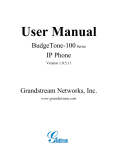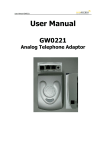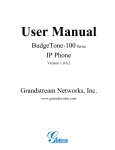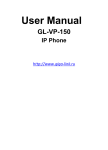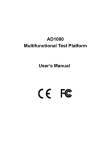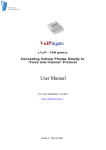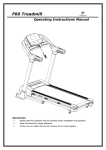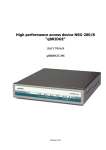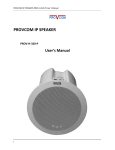Download User Manual - HipTel Broadband Phone
Transcript
User Manual IPPH 202 User Manual IPPH 202 VoIP Telephone IPPH 202 User Manual Table of Contents 1. WELCOME ............................................................................................................................. 2 2. WHAT IS IN THE PACKAGE .................................................................................................... 2 3. PRODUCT OVERVIEW ............................................................................................................2 3.1 Key Features ................................................................................................................. 2 3.2 Hardware Specification .................................................................................................. 2 4. INSTALLATION ...................................................................................................................... 2 5 BASIC OPERATIONS ............................................................................................................... 2 5.1 Get Familiar with Function Keys...................................................................................... 2 5.2 Dialing or Making Calls .................................................................................................. 2 5.2.1 Two dialing modes:.............................................................................................. 2 5.2.2 Call Hold ............................................................................................................. 2 5.2.3 Call Flash ............................................................................................................ 2 5.2.4 Call Transfer ........................................................................................................ 2 5.2.4.1 Blind Transfer ................................................................................................... 2 5.2.4.2 Attended Transfer ............................................................................................. 2 5.3 Receiving Calls .............................................................................................................. 2 5.4 Call Features ................................................................................................................. 2 6 PROGRAMMING IP PHONE 202................................................................................................ 2 6.1 Default Administrator Password: voip or admin 6.2 Major Sets of Configuration Data ...... 2 6.3 Programming Using Web Browser................................................................................... 2 6.3.1 Determine your VoIP device’s IP address............................................................... 2 6.3.2 User Programming and Configuration.................................................................... 2 6.3.3 Configuration Options and Explanations ................................................................ 2 6.3.4 Saving the Configuration Changes ........................................................................ 2 6.3.5 Rebooting the IP PHONE 202................................................................................ 2 6.4 Programming Using Keypad ........................................................................................... 2 7. TEST YOUR SETUP ................................................................................................................ 2 8. WARRANTY ........................................................................................................................... 2 1/21 IPPH 202 User Manual 1. WELCOME Prescient Worldwides's IP PHONE 202 is an internet telephone set that features superb audio quality, rich functionalities, high level of integration, and compactness. By converting analog voice for transmission over the internet, the IP Phone 202 allows users with broadband internet connections to make calls to and from anywhere in the world. The IP PHONE 202 is fully compatible with SIP industry standard and can interoperate with many other SIP compliant devices and software on the market. 2. WHAT IS IN THE PACKAGE The IP PHONE 202 package contains: 1) 2) 3) 4) One One One One IP PHONE 202 VoIP phone IP PHONE 202 phone handset universal power supply Ethernet cable 3. PRODUCT OVERVIEW 3.1 Key Features • • • • • • • • • • • • • • • • • • Supports SIP 2.0 Supports TCP/UDP/IP, RTP/RTCP, HTTP, ARP/RARP, ICMP, DNS, DHCP, NTP, TFTP protocols DHCP support for LAN or Cable modem PPPoE support for ADSL or Cable modem Supports IP address dynamic (DHCP) system Supports multi-method NAT traversal and anti-virus crossing Compliant with ITU-T standard and DTMF form and check Supports codecs G.723.1 (5.3K/6.3K), G.729A/B, iLBC, G.726, G.728, and wide-band G.722 sound coding and decoding Supports dynamic sound check VAD (Voice Activity Detection), CNG (Comfort Noise Generation), Line Echo Cancellation (G.168), and AGC (Automatic Gain Control) Dynamic sound technology with sound quality as good as traditional telephones Advanced Digital Signal Processing (DSP) to ensure superb hi-fidelity audio quality Support standard voice features such as Caller ID Display or Block, Call Waiting, Hold, Transfer Forward, FLASH, in-band and out-of-band DTMF (RFC2833), Dial Plans, off-hook auto dial, configurable emergency dialing (e.g., 911), early dial, click-to-dial Advanced adaptive jitter buffer control, packet delay & loss concealment technology Support multi-net construction Auto–manual indication Built-in world clock auto time display Has single or dual network ports (10 BaseT) Support dial code regulation based on E.164 2/21 IPPH 202 User Manual • • • • • • • • • • • • Support TFTP remote upgrade English language IE setting Dialed, received number check Speed dial function Emulate telephone dialing Easy volume adjustment IP-to-IP and point-to-point communication HiFi low delay net sound communication Local IP number, local number check Instant plug and play Full duplex hands-free speakerphone superior frequency Call forwarding, call waiting, call hold, call transfer, redial, call log, volume control, voice mail with indicator 3.2 Hardware Specification The table below lists the hardware specification of IP PHONE 202. Model IP PHONE 202 WAN interface 1 x RJ45 10 Base-T PC interface Available for IP PHONE 202B Product Color Almost Black or Grey Universal Switching Power Supply Input: 100-240VAC 50-60 Hz Output: +9VDC, 600mA, UL certified Dimension 23cm (L) 19cm (W) 10cm (H) All Package Weight 1.01kg Operation Temperature 0 – 40° C, Storage Temperature Humidity -30° –65° C, 10 - 95% 32° –104° F -22°– 149° F 4. INSTALLATION 1) Insert power adapter into back of the phone and connect it to a power outlet. 2) Connect internet cable from back of the phone (WAN Port) to broadband modem, router, hub, or switch. 3) For IP PHONE 202B, connect internet cable from back of the phone (PC Port) to a PC. 3/21 IPPH 202 User Manual Warning: Please do not use a different power adapter. Using other power adapter may damage the IP PHONE 202 and will void the manufacturer warranty. 5 BASIC OPERATIONS 5.1 Get Familiar with Function Keys Keypad Key 0 - 9, *(.), # + _ MENU CALLED CALLERS MSG HOLD TRANSF CONF FLASH MUTE/DEL REDIAL SPEAKER Memory Key M1-M10 Function(s) To input: numbers, *(.), # Scroll to next menu/submenu selection, or lower the volume of the loudhailer Scroll to previous menu/submenu selection, or rise the volume of the loudhailer Enter menu mode Show the phone number that has been called out Show the phone number that has been called in Get the voice message or other messages Hold the present call for the moment Transfer the present call to another number Conference call for three sides Used to switch between two lines Delete the call history, voice message, etc. Dial the last called number Enter the hand-free mode Under Development 5.2 Dialing or Making Calls 5.2.1 Two dialing modes: Ordinary dialing mode (4 ways): 1. Pick the up handset or press the “SPEAKER” button. 2. Press the REDIAL button to dial the Dial the last called number. 3. View the CALLED history and choose to redial. 4. View the CALLER history and choose to redial. IP address dialing mode: 1. Press “MENU” button to view the local IP address. 2. Dial the IP address and press “#” to start calling 5.2.2 Call Hold While in conversation, pressing the “Hold” button will put the remote end on hold. 4/21 IPPH 202 User Manual Pressing the “Hold” button again will release the previously Hold state and the bidirectional media will resume. 5.2.3 Call Flash Assuming that call party A and party B are in conversation. Party A wants to speak to party C or if there is another incoming call: 1. Party A presses FLASH to get a dial tone. 2. Party A then dials party C’s number then #. Party A and party C now are in conversation. 3. By pressing FLASH button, Party A can choose to have conversation with B or C. 5.2.4 Call Transfer 5.2.4.1 Blind Transfer The user can transfer an active call to a third party without announcement. Assuming that call party A and party B are in conversation. Party A wants to transfer party B to party C: 1. Party A presses TRANSF to get a dial tone. 2. Party A then dials party C’s number (do not press #). 3. Party A then press REDIAL. A quick confirmation tone if the transfer has been successful. B and party C now are in conversation. 4. Party A can hang up or make another call. Party Both A and B can generate Blind Transfer. 5.2.4.2 Attended Transfer The user can transfer an active call to a third party with announcement. Assuming that call party A and party B are in conversation. Party A wants to transfer party B to party C: 1. Party A presses Flash to get a dial tone. 2. Party A then dials party C’s number then #. 3. If party C is answered, press “TRANSF” to complete the transfer operation 4. If the call is not answered, pressing “flash” button to resume the original call. Both A and B can generate Attended Transfer. 5.2.5 3-Way Conference Call Assuming that call party A called party B, and now they are in conversation. Party A wants to let party C to attend the conversation: 1. Party A presses CONF to get a dial tone. 2. Then press party C’s number then # (or wait for 4 seconds). conversation. Party A and party C now are in 5/21 IPPH 202 User Manual 3. Party A presses CONF again, now the 3 parties are all in conversation. Both A and B can generate 3-way conference call. Note: The server needs to support this function for this feature or the phones to work. 5.3 Receiving Calls When phone rings from incoming calls and to receive the incoming calls, pick up the receiver or press the “SPEAKER” button. After picking up the call, to switch from hand free mode to receiver mode, just pick up the receiver and begin talking; the speakerphone will be deactivated. To switch from receiver mode to hand free mode, press down the “SPEAKER” button while placing the receiver back to resting location. Now the speakerphone is activated and you may continue speaking without receiver. 5.4 Call Features Following table shows the new call features of IP PHONE 202. Key *70 *72 Call Features Do Not Disturb. When someone call you, “do not disturb” busy tone will be heard. To use this feature, pick up the handset and dial “*70”. It will be cancelled when you hang up. Unconditional Call Forward. To use this feature, dial “*72” and get the dial tone. Then dial the forward number and “#” for a dial tone, and then hang up. *73 Cancel Unconditional Call Forward. To cancel “Unconditional Call Forward”, dial “*73” and get the dial tone, then hang up. *90 Busy Call Forward. To use this feature, dial “*90” and get the dial tone. Then dial the forward number and “#” for a dial tone, and then hang up. *91 Cancel Busy Call Forward. To cancel “Busy Call Forward”, dial “*91” and get the dial tone, then hang up. *92 Delayed Call Forward. To use this feature, dial “*92” and get the dial tone. Dial the forward number and “#” for a dial tone and then hang up. *93 Cancel Delayed Call Forward. To cancel this feature, dial “*93”, get the dial tone, and then hang up. When in conversation, this action will switch to the new incoming call if there is a call Flash/Hook waiting indication. When in conversation without an incoming call, this action will switch to a new channel to make a new call. 6 PROGRAMMING IP PHONE 202 6/21 IPPH 202 User Manual 6.1 Default Administrator Password: voip or admin 6.2 Major Sets of Configuration Data There are 8 major sets of data related to the programming of the IP Phone 202: IP Type, IP Address, Subnet Mask, Router, DNS Server1, DNS Server2, Account, and Password. The IP Phone 202 needs to be assigned an IP address in order for it to access the internet and make telephone calls. There are 2 kinds of IP address types (IP Type): 1) IP Type 0 (Static): IP address is manually entered by you. There are 5 fields to be filled: IP Address: 192.168.0.160 (default) Subnet Mask: 0.0.0.0 Default Router: 0.0.0.0 DNS Server1 (DNS using): 0.0.0.0 DNS Server2 (DNS spare): 0.0.0.0 2) IP Type 1 (DHCP): IP address is dynamically assigned by router, if any, at the location, thereby allowing it to access the internet and make calls. Plug the IP Phone 202 into the router using the LAN port connection. The IP address is assigned to the IP Phone 202 automatically. 3) User Account: Assign your own user name 4) User Password: Assign your own password 6.3 Programming Using Web Browser IP PHONE 202 has embedded Web server and HTML pages that allow users to configure the IP PHONE 202 through an easy-to-use Web browser interface such as Microsoft’s Internet Explorer or Netscape browser. Below is a screen shot of the IP PHONE 202 configuration page: 7/21 IPPH 202 User Manual 6.3.1 Determine your VoIP device’s IP address. On the IP PHONE202 (while handset is up) push the “MENU” key to obtain the phone’s IP address, which will show on the LCD screen. If the IP address is all “0”s, then your VoIP device does not have internet connection. Please go back to step 1 and check your installation before proceeding. 6.3.2 User Programming and Configuration From your web browser, the IP PHONE 202 will show the following login screen: Password: voip or admin 6.3.3 Configuration Options and Explanations After a correct password is entered in the login screen, the embedded web server inside the IP PHONE 202 will show the configuration page, which is explained in details below: SIP Settings: 8/21 IPPH 202 User Manual SUPER USER OPTIONS PAGE Options SIP Server Address Outbound Proxy SIP User ID Account ID Authentication Password Name Use DNS SRV: User ID is Phone Number SIP Settings Meaning Gatekeeper's / SIP Server’s URL or IP address SIP Outbound Proxy Server’s URL or IP address SIP service subscriber’s User ID SIP service subscriber’s Authenticate ID. Can be identical to, or different from, SIP User ID SIP service subscriber’s account password(for security, the password does not display) SIP service subscriber’s name which will be used for Caller ID display Default is No. If set to Yes, then the client will use DNS SRV for server lookup If the IP PHONE 202 has an assigned PSTN telephone number, then this field should be set to “Yes”. Otherwise, set it to “No”. If “Yes” is set, a “user=phone” parameter will be attached to the “From” header in SIP request message to SIP server SIP Registration This parameter controls whether the IP PHONE 202 needs to send REGISTER messages to the proxy server. The default setting is “Yes”. Unregister on Reboot Default is “No.” If set to “Yes”, then the SIP user will be unregistered on reboot. Register Expiration This parameter allows the user to specify the time frequency (in minutes) the IP PHONE 202 refreshes its registration with the specified gatekeeper/SIP server. The default interval is 60 minutes (or 1 hour). The maximum interval is 65535 minutes (about 45 days). Local SIP Port This parameter defines the local SIP port the IP PHONE 202 listens and transmits signals. The default value is 5060. Local RTP port This parameter defines the local RTP-RTCP port pair the IP PHONE 202 will listen and transmit signals. It is the base RTP port for channel 0. When configured, channel 0 will use this port _value for RTP and the port_value+1 for its RTCP; channel 1 will use port_value+2 for RTP and port_value+3 for its RTCP. The default value is 5004. Use Random Port When set to “Yes”, this parameter will force random generation of both the local SIP and RTP ports. This is usually necessary when multiple IP PHONE 202 are behind the same NAT. NAT Traversal This parameter defines whether the IP PHONE 202 NAT traversal mechanism will be activated or not. If activated (by choosing “Yes”) and a STUN server address is also specified, then the IP PHONE 202 will automatically follow the STUN client specifications. Under this mode, the embedded STUN client inside the IP PHONE 202 will attempt to detect if there is a (and type of) firewall/NAT it is sitting behind through communication with the specified STUN server. If the detected NAT is a Full Cone, Restricted Cone, or a Port- Restricted Cone, the IP PHONE 202 will attempt to use its mapped public IP address and port in all of its SIP and SDP messages. If the NAT Traversal field is set to “Yes” with no 9/21 IPPH 202 User Manual specified STUN server, the IP PHONE 202 will periodically (every 20 seconds) send a blank UDP packet (with no payload data) to the SIP server to keep the “hole” on the NAT open. Keep Connected Interval This parameter specifies how often the IP PHONE 202 sends a blank UDP packet to the SIP server in order to keep the “hole” on the NAT open. Use NAT IP: NAT IP address used in SIP/SDP message. Default is blank. Proxy-Require SIP Extension to notify SIP server that the unit is behind the NAT/Firewall. Send DTMF This parameter controls how DTMF events are transmitted. There are 3 ways: In-Audio which means DTMF is combined in audio signal (not very reliable with low-bit-rate codec), via RTP (RFC2833), or via SIP INFO. DTMF Payload Type This parameter sets the payload type for DTMF using RFC2833 Send Anonymous If this parameter is set to “Yes”, the “From” header in outgoing INVITE message will be set to anonymous, essentially blocking the Caller ID from displaying. Send Flash Event This parameter allows users to control whether to send a SIP NOTIFY message indicating that the phone’s Flash key has been pushed, or just to switch to the voice channel when users press the Flash key. Audio Settings: 10/21 IPPH 202 User Manual Audio Settings Options Preferred Codec G723 Rate: iLBC Frame Size: Meaning The IP PHONE 202 supports up to 7 different Codec types including G.711 G.723.1, G.726, G.728, G.729A/B, iLBC. Users can configure Codecs in a preference list that will be included with the same preference order in SDP message. The first Codec in this list can be entered by choosing the appropriate option in “Choice 1”. Similarly, the last Codec in this list can be entered by choosing the appropriate option in “Choice 7”. This defines the encoding rate for G723 codec. By default, 6.3kbps rate is chosen. This defines the size of the iLBC codec frame. The default setting is 20ms. iLBC Payload Type: This defines payload time for iLBC. Default value is 97. Voice Frames per TX This field contains the number of voice frames to be transmitted in a single packet. When setting this value, the user should be aware of the requested packet time (used in SDP message) as a result of configuring this parameter. This parameter is associated with the first codec in the above codec Preference List or the actual used payload type negotiated between the 2 conversation parties at run time. For example, if the first codec is configured as G723 and the “Voice Frames per TX” is set to be 2, then the “ptime” value in the SDP message of an INVITE request will be 60ms because each G723 voice frame contains 30ms of audio. Similarly, if this field is set to be 2 and if the first codec chosen is G729 or G711 or G726, then the “ptime” value in the SDP message of an INVITE request will be 20ms. If the configured voice frames per TX exceeds the maximum allowed value, the IP PHONE 202 will use and save the maximum allowed value for the corresponding first codec choice. The maximum value for PCM is 10(x10ms) frames; for G726, it is 20 (x10ms) frames; for G723, it is 32 (x30ms) frames; for G729/G728, 64 (x10ms) and 64 (x2.5ms) frames, respectively. Layer 3 QoS This field defines the layer 3 QoS parameter, which can be the value used for IP Precedence or Diff-Serv or MPLS. Default value is 48. Layer 2 QoS This contains the value used for layer 2 VLAN tag. Default setting is 0. Silence Suppression This controls the silence suppression/VAD feature of G723 and G729. If set to “Yes”, when a silence is detected, small quantity of VAD packets (instead of audio packets) will be sent during the period of no talking to make the connection feel more "natural". If set to “No”, this feature is disabled. 11/21 IPPH 202 User Manual Phone Features Settings: Options Early Dial Dial Plan Prefix No Key Entry Timeout Use # as Dial Key Auto Answer Voice Mail Phone Features Settings Meaning Default is “No”. Use only if proxy supports 484 response Sets the prefix added to each dialed number Default is 4 seconds. This is the time lapse after entering a phone number for the IP PHONE 202 to begin completing your call. This parameter allows users to configure the “#” key to be used as the “Send / Enter” (or “Dial”) key. If set to “Yes”, pressing this key will immediately trigger the sending of dialed numbers entered thus far. In this case, this key is essentially equivalent to the “(Re)Dial” key. If set to “No”, this “#” key will then be included as part of the dial string to be sent out. Default is NO. When set to yes the phone will automatically pick up the call and turn the speaker on. This parameter defines the User ID (or extension number) of a 3rd party voice mail system where the user may have an account. By Voice Mail UserID defining this Voice Mail extension, when the user presses the “Message” button on the phone, an INVITE message will be sent to that extension to allow the user to retrieve messages. This parameter allows users to configure a User ID or extension number to be automatically dialed upon off-hook. Please note that only the user part of a SIP Off-hook Auto-Dial address needs to be entered here. The IP PHONE 202 will automatically append the “@” and the host portion of the corresponding SIP address. Default is “No”. If set to “Yes”, Call Forwarding & Do-Not-Disturb are supported Enable Call Features locally 12/21 IPPH 202 User Manual Disable Call Waiting Default is “No”. Default Ring Tone The user can setup up one number on each of the ring tones 1, 2 and 3. When a call is received from one of these numbers, the respective ring tone will be generated. Other Settings: Options Firmware Upgrade via TFTP server Firmware Upgrade via HTTP server Other Settings Meaning The IP of TFTP server needs to be configured. If it is non-zero or not blank, the IP phone will attempt to retrieve new configuration file or new code image from the specified tftp server at boot time. It will make up to 3 attempts before timeout and then it will start the boot process using the existing code image in the Flash memory. If a tftp server is configured and a new code image is retrieved, the new downloaded image will be verified and then saved into the Flash memory. Be careful when the TFTP is in progress (the phone back light on LCD screen will be up). Do NOT interrupt the process (especially the power supply) otherwise might cause the device dead. Be patient as in some network this process will take up to 15 minutes. The URL for the HTTP server used for firmware upgrade and configuration via HTTP. For example, http://upgrade.myVoIPservice.com:6688/IP PHONE202 Here “:6688” is the specific TCP port that the HTTP server is listening to, it can be omitted if using default port 80. Note: Auto Upgrade has to be set to “Yes” to enable HTTP upgrade. 13/21 IPPH 202 User Manual Auto Upgrade Choose Yes to enable HTTP upgrade and provisioning. In “Check for new firmware every ___ days” field, enter the number of days to check the HTTP server for firmware upgrade or configuration. NTP Server This parameter defines the URI or IP address of the NTP server which the IP phone will use to synchronize the current date/time. SUBSCRIBE for MWI Default is “No”. When set to “Yes” a SUBSCRIBE for Message Waiting Indication will be sent periodically. FXS Impedance Lock Keypad Update Debug Server Address Selects the impedance of the analog telephone connected to the Phone port. If this parameter is set to “Yes”, the configuration update via keypad is disabled. Debug Level Default is “None”. Choose the debug level you want when using this function. Super Password Default is voip or admin. This contains the password to access the Advanced Web Configuration page. This field is case sensitive. This parameter defines the URI or IP address of the Debug server. Network Settings Network Settings Options Meaning If DHCP mode is enabled, then all the field values for the Static IP mode are not Dynamically Assigned used (even though they are still saved in the Flash memory) and the IP phone will IP acquire its IP address from the first DHCP server it discovers on the LAN it 14/21 IPPH 202 User Manual Static IP attaches to. PPPoE account settings can be configured here too if the user is using DSL/ADSL connection. Users can specify DNS server manually by entering DNS server’s IP address. If Static IP mode is selected, then the IP address, Subnet Mask, Default Router IP address, DNS Server 1 (primary and mandatory), DNS Server 2 (secondary and optional) fields will need to be configured. These fields are reset to zero by default. Other settings: Other Settings Options Meaning Time Zone This parameter controls how the displayed date/time will be adjusted according to the specified time zone. Daylight Savings Time This parameter controls whether the displayed time will be daylight savings time or not. If set to Yes, then the displayed time will be 1 hour ahead of normal time. Date Display Format This parameter controls the date display format. Basic User Password This contains the password to access the Basic Web Configuration page. This field is case sensitive. 15/21 IPPH 202 User Manual Device Status Device Status fields Meaning MAC Address The device ID, in HEX format. This is very important ID for ISP troubleshooting. WAN IP Address This field shows WAN port IP address. Software Version This field shows the software version. System Up Time This shows system up time since last reboot. Registered This shows whether the unit is registered to service provider’s server. PPPoE Link Up This shows whether the PPPoE is up if connected to DSL modem. NAT This shows what kind of NAT the IP PHONE 202 is behind if it is not in oper interne. NAT Mapped IP WAN side public IP if connected to LAN of a SOHO NAT router. Other Status Please refer to the page displayed. 6.3.4 Saving the Configuration Changes Once a change is made, users should click on the “SaveSet” button in the Configuration page. 16/21 IPPH 202 User Manual The IP PHONE 202 will then display the following screen to confirm that the changes have been saved. Please wait 5 seconds and then reboot the device. 6.3.5 Rebooting the IP PHONE 202 You can reboot the IP PHONE 202 by clicking on the “Reboot” button after each update to the configuration page. Alternatively, you can reboot by unplugging the power supply of the IP PHONE 202 and then powering it on again. If your IP PHONE 202 ever becomes “stuck” or un-responsive, you can unplug the power supply to reboot it. Frequent rebooting by unplugging the power supply is not recommended and should not be necessary. 17/21 IPPH 202 User Manual 6.4 Programming Using Keypad Configure with keypad Menu Item 1 2 3 4 5 6 7 Menu function(s) Show“[1]dhcp on” Press“[1]dhcp off”as the current option Press MENU and enter the menu mode Press “+”or“-”to choose Press MENU to save or exit Restart to be effective!!! Show “[2]IP Addr” Press MENU to show the current IP address If DHCP is OFF,enter new IP address Press“+”or“-” to exit Press MENU to save or exit Restart to be effective!!! Show“[3]SubNet” Press MENU to show subnet address If DHCP is OFF,enter new subnet address Press“+”or“-”to exit Press MENU to save or exit Restart to be effective!!! Show“[4]routEr ” Press MENU to show router/gateway address If DHCP is OFF, enter router/gateway address Press“+”or“-”to exit Press MENU to save or exit Restart to be effective!!! Show“[5]dnS ” Press MENU to show DNS address If DHCP is OFF, enter new DNS address Press“+”or“-”to exit Press MENU to save or exit Restart to be effective!!! Show“[6]tFtP ” Press MENU to show tFtP address Enter new tFtP address Press“+”or“-”to exit Press MENU to save or exit Show “[7] G-711u 2” Press MENU to show current codec Press ‘+’ or ‘-’ to view all codec options 1 “ - G-711A 2” 2 “ - G-722 2” 3 “ - G-723 1” 4 “ - G-726 2” 5 “ - G-728 8” 6 “ - G-729 2” 7 “ - iLBC 1” 18/21 IPPH 202 User Manual 8 9 10 11 Others Press 1 to 9 to choose the frame number Press MENU to exit. No need to restart Show“[8]SIP SP-1” Press MENU to show SIP server/ service provider Press“+”or“-”to view all usable SIP server (1-9) Press MENU to save and exit SIP server must be configured through Web browser Show “[9] codE rEL” Press Menu to display the code releases Press ‘+’ or ‘-’ to view 1 “b 2004-06-12” – date: boot code 2 “ 1. 0. 0.18” – version: boot code 3 “P 2004-06-21” – date: phone code 4 “ 1. 0. 5. 3” – version: phone code 5 “c 2004-05-06” – date: vocoder 6 “ 1. 0. 0. 6” – version: vocoder 7 “h 2004-06-17” – date: web server 8 “ 1. 0. 0. 36” – version: web server 9 “1r 2004-05-12” – date: 1st ring tone 10 “ 1. 0. 0. 0” – version: ring tone 11 “2r 2004-05-12” – date: 2nd ring tone 12 “ 1. 0. 0. 0” – version: ring tone 13 “3r 0000-00-00” – date: 3rd ring tone 14 “ 0. 0. 0. 0” – version: ring tone (all show 0 means not usable or not supported) Press Menu to exit Show“[10]Phy Addr” Press MENU to show MAC address Press“+”or“-”to exit Show “[11] ring 0” Press MENU to hear current ring tone Press ‘+’ or ‘-’ to choose ring tones 4 ring tones available at present:ring0(default), ring1,ring2.ring3 are not usable or not supported。 Press MENU to choose and save Be effective directly. No need to restart. Show “ -- rESEt --”, ATTENTION: A> Enter MAC address and press MENU ,IP PHONE 202 will restart and get back to all default setting. All former configuration will be lost. B> Press MENU and the phone will restart. When in the mode: • Press‘+’ or ‘-’ and show“ ring [4] ”, press ‘+’ or ‘-’ to adjust the ring volume form 0 to 7 • Press “SPEAKER” , or pick up handset, then press ‘+’ or ‘-’ to adjust voice volume. 19/21






















